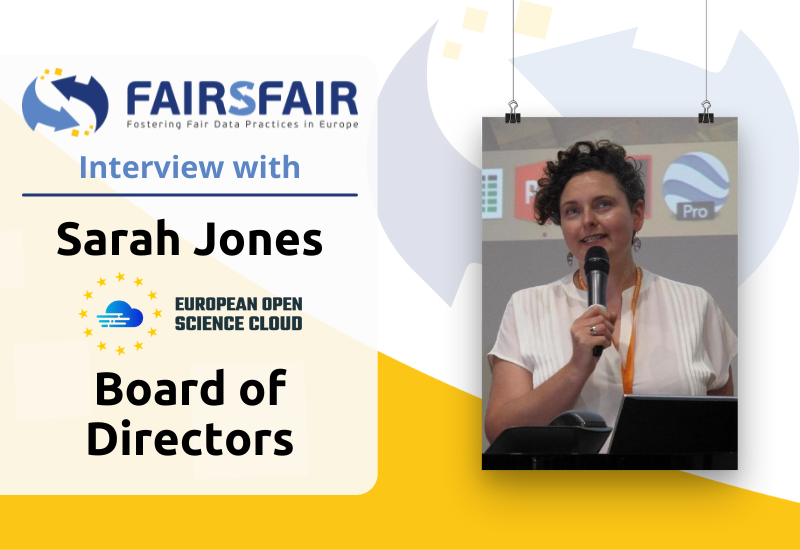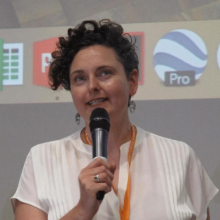Part of a series of interviews with the EOSC Association Board of Directors.
September 2021
 On 30 August 2021 FAIRsFAIR released the report of the third FAIRsFAIR Synchronisation Force workshop, organised online as a series of six sessions from 29th of April until 21st of May 2021. The objective of these sessions was to survey the current state of activity towards implementing the recommendations outlined in the Turning FAIR into Reality report (2018), and to provide indicators of the amount of activity being undertaken. The report provides an overview of activities being undertaken by projects involved in building a FAIR ecosystem for the European Open Science Cloud. The report also offers a representation of the amount of activity being undertaken towards each recommendation across the projects and initiatives that participated.
On 30 August 2021 FAIRsFAIR released the report of the third FAIRsFAIR Synchronisation Force workshop, organised online as a series of six sessions from 29th of April until 21st of May 2021. The objective of these sessions was to survey the current state of activity towards implementing the recommendations outlined in the Turning FAIR into Reality report (2018), and to provide indicators of the amount of activity being undertaken. The report provides an overview of activities being undertaken by projects involved in building a FAIR ecosystem for the European Open Science Cloud. The report also offers a representation of the amount of activity being undertaken towards each recommendation across the projects and initiatives that participated.
We have talked about the report, which is of particular value for the EOSC Association as well as for the European Commission’s EOSC programme, with Sarah Jones, member of the EOSC Board of Directors.
According to the report, broadly speaking there is a good level of activity towards the TFiR recommendations. This is particularly strong in the area of defining and communicating the definition of FAIR and preparing metrics for FAIR Digital Objects and Outputs. Nonetheless, it remains important to further extend activities on vocabularies, ontologies, metadata, semantics for existing and emerging cross-domain research areas, as well as on supporting machine-actionable DMPs. Aspects such as supporting smaller repositories in their path towards certification emerge also as still very relevant.
Given your current role of EOSC Association Director and experience of advocating FAIR data in Europe, do you share the positive outlook from the report? Are researchers and research performing organisations in Europe on the road towards a FAIR management of data?
I find the mapping exercise conducted by the Synchronisation Force incredibly valuable. It helps to identify those areas where much progress is being made and gaps where more work is needed. I agree that the understanding of FAIR has greatly improved over recent years, we have made good progress on defining metrics, and lots is currently being done on defining interoperability frameworks to enable data exchange across communities, notably in the EOSC Future project which is bringing together the eInfrastructures and research clusters. Research performing organisations are also increasingly active in this space, but there is still a lot of work to do to connect their support and services into the EOSC ecosystem.
How do you see these recommendations fitting with the priorities identified in the SRIA and the work of the Advisory Groups being formed by the Association?
The recommendations align well with the SRIA and Advisory Groups. Gaps identified in the Turning FAIR into Reality report around FAIR not covering long-term preservation or data quality, and flagging the importance of research software have all been picked up in the new Advisory Groups and Task Forces. Follow-up actions that you note, such as putting more effort towards developing registries and implementing automated workflows are also addressed in the SRIA.
Which communities are having greater success in adopting FAIR data principles, and which require further work?
The analysis conducted by the EOSC FAIR Working Group on the implementation of FAIR practices gives a useful overview of which communities are further along in adopting FAIR principles. The bio- and natural sciences are well advanced but there are differences within specific fields in these areas. The report found that divides between more and less advanced groups do not strictly follow discipline boundaries. They often depend on the types of data collected, country or region where the researcher is based and age group. If there is a culture within the community and tools and support to enable change then FAIR practices develop, so this is what we should focus on enabling.
Given your past experience at DCC, what should be the strategic aspects to focus on to support smaller repositories?
As noted in your report, it is a challenge for smaller or institutional repositories to meet CoreTrustSeal certification, as the elements focus on domain specific support and require a high-level of formal processes. Programmes to support them through the certification process as offered through FAIRsFAIR are certainly useful, but I would also advocate for more repository networks to share skills and capacities across organisations or external services, for example on digital preservation, that repositories can plug into rather than addressing these aspects themselves. The 4TU research repository and Data Curation Network are good examples here. Cross-cutting services such as OpenAIRE or domain networks like CESSDA which harvest information from repositories and help to expose it more widely, for example by assisting in any conversions needed to make it accessible via EOSC are also key.
How important are the mechanisms of synchronization and alignment, such as collaboration agreements, cross-project collab board, MoUs, SynchForce, or FAIR champions in the EOSC framework?
There is so much activity going on within the EOSC community that synchronising this and collaborating to reduce duplication is key. The work happening on monitoring is a good example here with the EOSC Association, Steering Board, EOSC Future and other projects all pooling knowledge and ensuring surveys are aligned and results shared across them. I find that getting people together and working on activities collectively is far more useful than MoUs or collaboration agreements, though these are often needed to formalise partnerships.

